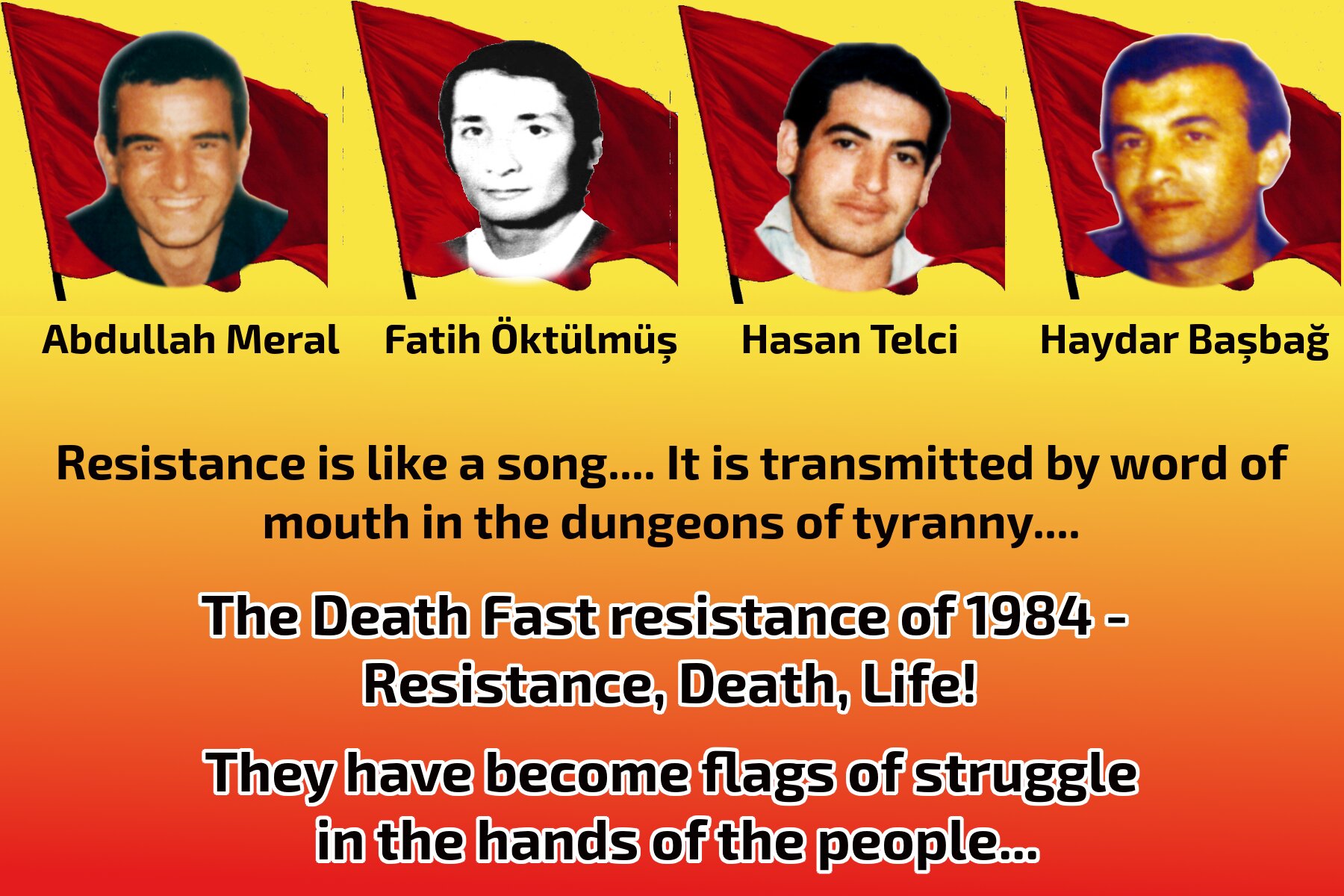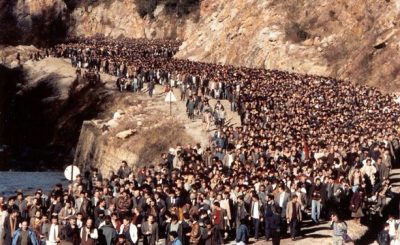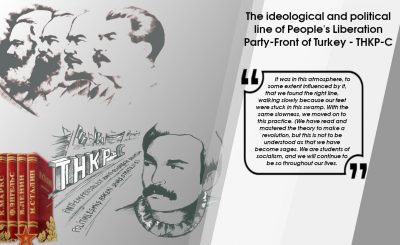Location: Prisons in Turkey
Period: April – May – June 1984
On the morning of September 12, 1980, the fascist military junta usurped power in Turkey. It began to destroy, scatter, and destroy everything that was against her. Arrests, torture, extrajudicial killings, and finally prisons … The junta wanted to crush 45 million people.
As the junta came to power, prisons became an arena for sharp clashes with the junta. The junta, in the first years of its rule, managed to largely neutralize the opposition outside the prisons, and immediately after that it started its attacks against the prisons, which did not shut up, did not surrender, which had become strongholds of resistance.
Those who had found the solution in fleeing abroad as soon as they felt the junta breathing down their necks, those who had “frozen” the struggle did not behave differently inside prisons. While experiencing the consequences of their distrust of the strength of the people, and the loss of their faith in the revolutionary cause, they were busy looking for a comfortable disguise for their capitulation. The Revolutionary Left(Devrimci Sol) movement, which welcomed the junta with its struggle outside the prisons, continued this line inside the prisons. The attacks in prisons had begun before the junta came to power, and after it came to power, these attacks have been intensified.
On the front lines of the prisons, Mamak Prison located near Ankara fell first, it was followed by the Diyarbakir dungeon. The enemy was screaming of the joy of the victory that it has achieved. It was time to take over the prisons in Istanbul. In April 1981, political prisoners, from all prisons in Istanbul, were transferred at the Metris Military Prison located then in the outskirts of the city. Here the junta tried to get the same result as in the military prison – Mamak, near Ankara. It wanted to crush the will of revolutionaries by forcing them to renounce their ideals and submit completely to its will while being ready to endure the most inhuman and abominable tortures.
The revolutionary political prisoners managed to neutralize and repel all enemy attacks in the Metris prison. Through hunger strikes and barricades in the cells, they resisted the junta in various ways. On the agenda was the introduction of compulsory prison uniforms for political prisoners, this was the largest attack by the junta. The political prisoners, in turn, responded by turning their bodies into weapons. A Death Fast(hunger strike till death) has begun.
In April 1984, Metris was ready for a new great resistance, and a great radical change. And so the long-awaited spark was ignited by 14 revolutionaries, in isolation, in the worst and most disgusting ward of the prison – ward B-2. On April 11, revolutionaries from other wards of the prison joined the hunger strike that began in, ward B-2. On April 13, after the female political prisoners in the women’s ward joined the hunger strike, this time the revolutionaries in Sağmalcılar Prison(also known as Bayrampaşa prison) joined the hunger strike. The clash of wills of the two classes, in this conflict, had reached its highest stage. The road to be walked was long, the goal was great. Fully aware of this, the junta was activated from the very beginning to destroy the resistance.
The enemy directed its attacks first at those political prisoners involved in the hunger strike who were outside the isolation cells. Those scenes familiar to everyone in Metris began to play out. The corridors were full of soldiers armed with batons, with icy and insensitive glances, ready to attack at any moment. The officers who entered the cells began to read the names one by one. It was an internment operation. The political prisoners were taken to the farthest ward of Metris, the so-called Siberia, located in the northern part of sector “E”. The so-called Siberia was far from all other sectors, there was no running water, the electricity was often cut off, and the cold here penetrated to the marrow of the human bones. In this way, the enemy, transferring in one place all the resisting political prisoners, wanted to isolate them from the others and separate them with thick concrete walls between them.
The enemy attacked to break the resistance. All the clothes of the political prisoners were made to pieces. Under the blows of the batons, their skin peeled. The political prisoners grabbed each other and responded to the attack by chanting slogans. The slogans “Down with Fascism!” “We are not soldiers, we are political prisoners!” All the political prisoners participating in the hunger strike were proud and satisfied with the fact that after arriving in Siberia, they managed to repel the attacks as one and continue the resistance. They greeted the night with songs about the on their lips…
The doors of the isolation ward opened on the eve of May 1, around 3:00 p.m. Along with the opening of the door, the enemy officer appeared. With his green beret on his head, smoking a cigarette in his mouth, he looked at the revolutionaries. The 14 political prisoners, who had been on hunger strike for 21 days, immediately clung to each other. But this time the enemy had not come for one of its well-known operations. He had come up with a new method to break the resistance. The colonel, who was Metris’s chief executioner, had taken on the role of “sage” this time.
“-Your friends in Sağmalcılar Prison take water with sugar, why are you stubborn and refuse to take it? The colonel asked softly.”
The colonel, who knew that the resisting political prisoners did not accept sugar, tried to use this tactic to “open a hole” in the resistance. But the political prisoners, who knew the enemy and the colonel equally well, immediately answered his question:
-Take your sugar and leave!
After the answer he received, the only thing the colonel could do was get out of the cell. An hour later, the names of the 14 political prisoners were read out and they were interned in Sağmalcılar Prison. The political prisoners, who also repulsed this attack by the enemy on the morning of May 1, went to the Sağmalcılar Prison in Istanbul.
Resistance, Death, Life…
The hunger strike continued, and following the prepared program, it went through its stages. Again following the program, on the 30th and 40th day, one of the groups of political prisoners interrupted the hunger strike. On day 45, the breaths filled with hunger reached a new stage in the struggle. To make the tyrants retreat, the bodies now carried the weapon of death. Tyranny would be defeated by a Death Fast (hunger strike till death).
On the 45th day of a hunger strike with an announcement in Sağmalcılar Prison and on the 49th day with an announcement in Metris Prison, the beginning of the Death Fast resistance was announced.
A total of 16 political prisoners from the Revolutionary Left (Turkish: Devrmici Sol) and the Union of Revolutionary Communists of Turkey (Turkish: Türkiye İhtilalci Komünistler Birliği-TİKB), with the honor of being the first volunteers to bear the weapon of death, started an “attack” against the enemy. The revolutionaries began the Death Fast resistance, with all their faith in victory and their comrades wrote their wills to their families and comrades.
The resistance also resonated in prisons across Anatolia. Political prisoners from the Revolutionary Left(Devrimci Sol) in the prisons in Elazığ, Northern Kurdistan(eastern Turkey), Bartın, northern Turkey, and Çanakkale, northwest Turkey, also went on a Death Fast. The Death Fast resistance, have increased the enemy’s fears. Fearing possible deaths, around the 30th day of the hunger strike, the enemy began sending political prisoners participating in the resistance, to hospitals. The enemy, taking into account the effect that the deaths in prisons would have, forcibly transferred the political prisoners participating in the Death Fast resistance to the Haydar Paşa Military Hospital in Istanbul. The death fast resistance continued in the wards of Haydar Paşa Military Hospital, which were no different from dungeons.
As the last minutes of the 63rd day of the Death Fast resistance was passing, when the clock struck 23:40 (local time), a voice was heard in the hallway of one of the wards of the hospital.
-Comrades, Apo[1] fell martyr!…
Apo, who during the marathon lasted 63 days, whenever he was asked, “How are you, Apo?”, Always answered, “I’m fine, fine!” Was the first to hit the enemy in the brain. Apo, who said, “I will fell martyr first,” closed his eyes with the honor of overcoming death and becoming a harbinger of victory. All of his comrades gathered around Apo. They were one step closer to the victory. They all get hand in hand with each other, with the power of overcoming the death tonight, but also with the pain and anger of losing Apo. His comrades prepared Apo for the ceremony. Apo’s body was cleaned with soapy water and then dried. His bed was covered with clean sheets. He was wearing clean underwear and pajamas. His jaw and toes were bandaged, and red carnations were placed on him. Apo seemed to be smiling among the red carnations to his comrades, that he had left behind. Hands were raised for Apo, everyone clenched their left fists. With his voice exhausted from death, Hasan Telci[2] began reciting, a poem in the hospital room to pay tribute to his comrade.
This time our leader started talking about Apo:
“-Tonight we defeated the death, comrades… No Apo does not die, he will live in all the struggles in which honor is defended… Now we will take the flag of honor that he carried.”
In the hours following Apo’s death, Fatih and Haydar[3] had lost consciousness. They did not understand what was happening. They were also told the news of Apo’s death. Gathering all his strength, Fatih, clenching his fist, shouted: “Comrades like Apo, do not die!”, Followed by slogans:
“Comrades like Apo do not die!”
“The martyrs of the Death Fast are immortal!”
The news of Apo’s martyrdom quickly reached Sağmalcılar Prison. On the evening of the 67th day of the Death Fast resistance, the voices of the political prisoners in all the cells echoed as one. After Apo, Fatih, and Haydar fell one after another, the revolutionaries had managed to bring together in one day the deaths of two fighters. As anger was overflowing from everyone, victory drew nearer more and more.
Day 66, June 17, 1984, Sunday.
At 6:15 a.m.(local time), the Death Fast resistance gave its second martyr. Haydar Başbağ martyred. His comrades arranged the same ceremony like the one for Apo. In the minutes when his comrades were sending Haydar to immortality, this time their comrade-in-arms, Fatih Öktülmüş of the Union of Revolutionary Communists in Turkey(TİKB), fell martyr.
On the 69th day of the Death Fast, threatening our leader, the enemy tried to divide, destroy, and break the resistance. The enemy did not hesitate to organize an operation against the revolutionaries, who fought against the death for 69 days. They managed to tear away, our leader, only through a military operation. But even that failed to break the resistance.
The Death Fast resistance ended on the 75th day after Sinan Kukul(one of the leading cadres of Devrimci Sol) whispered a special password, first to his comrades in his prison ward and then to those in the hospital.
As he was leaving the hospital, Sinan Kukul turned to his comrades, and said the following:
-Comrades, you have created an impressive and worthy resistance. Our resistance has reached its goal. Now it is important to return to life. We want to see all of you, again among us, as soon as possible. Take good care of yourself.
The 75-day war, between the will of the revolutionaries and the will of the enemy, was won by those who turned their bodies into weapons against death.
The Death Fast resistance was a historical example of revolutionaries that will not surrender despite the despondency, despair, and betrayal.
The Death Fast resistance has become a byword for devotion to the cause of the revolution, and self-sacrifice in the name of the people.
The Death Fast resistance, with its consequences, was a political victory. All weapons were taken from the hands of the enemy, and the initiative in prisons was in the hands of the revolutionaries.
Source:
http://www.ozgurluk.info/sehitlerimiz/direnisler-html/1984%20Olum%20Orucu%20Direnisi.htm
Footnotes:
1- Refers to Abdullah Meral, the first revolutionary to die in the Death Fast resistance in 1984
2- Refers to Hasan Telci, died on June 27, 1984, becoming the 4th revolutionary to fell, martyr, the Death Fast.
3- Refers to Fatih Öktülmüş and Haydar Başbağ, who martyred one after the other during the Death Fast.



